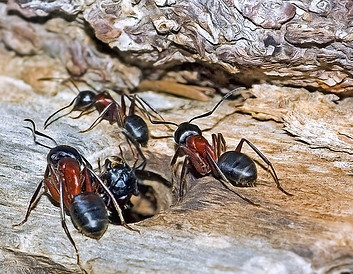Carpenter Ants
Premium Pest Solutions
Haley Pest Control of Lawrence Can Help Rid Your Home of Carpenter Ants
In their natural habitat, carpenter ants, are beneficial insects. They excavate galleries in wood and meticulously finish and clean surfaces, earning themselves their name. Their galleries open up damp and rotting wood so decomposers, such as other insects and fungi, can start working. They also feed on many pests.
They are the largest domestic common ant, measuring from 6 to 14 mm in length for the brown or black workers, and more than 25 mm for the queen. In late spring and early summer, mature colonies develop reproductive castes, which have wings and swarm in mating flights, often making a nuisance of themselves in and around homes.

Outdoors, they nest in moist wood, such as stumps, landscape ties and wooden fence posts.
In buildings, they often make their nests in doors, wood cabinets near dishwashers, damp locations behind baseboards, fireplaces, window frames, and in basements and attics.
Although they normally excavate their nests in wood, they also nest in untreated polystyrene insulation, fiberglass and other insulating materials. Carpenter ants will rarely do extensive damage to wood. The colony is usually limited to the area of damp wood, although several so-called satellite colonies may be constructed in the same structure.
Carpenter ants may roam infested buildings throughout the year, searching for food at considerable distance away from the nest. In some colonies, they are dormant for several weeks during the winter months. Carpenter ants concentrate glycerol in their tissues to reduce freezing over the winter. Although they chew through wood, leaving sawdust like particles, they do not eat wood. Instead, they feed on a wide range of insects, plant materials and on occasion human food. All waste is dumped through the nest opening, so the nest is kept clean. This behavior often reveals the nest site.
Prevention
Remove decaying wood from around buildings, and store firewood outdoors away from direct soil contact in well-ventilated conditions. For example, place it on a flat platform supported by concrete blocks, away from the house. Ensure good ventilation and drainage around the building so the wooden parts stay dry. Repair or replace leaky water and drainage pipes. Store food in closed containers and keep kitchen counters and shelves clean. Clean up syrup, sugar or other sweet foods.
Carpenter ants usually locate their nests in moist wood near a water source, such as a leaking roof, leaking or sweating pipes or a dishwasher. Sugar, syrup, honey or jam can be wiped on a plastic lid or wrapping and placed in an ant infested area. The ants will find the food source, gorge themselves and return to the nest, revealing their location (Feeding occurs most commonly during the evening. Carpenter ants do not use chemical scent trails or pheromones to signal where they have found food as extensively as other pest ants, so ant traps containing quick knockdown insecticides have limited success in controlling them.
Additional Preventative Measures
Check the structural strength of the wood that has been colonized by ants, replacing that which is weak and rotten. Repair all roof leaks and correct condensation problems, which attract carpenter ants. It is best to use pressure-treated lumber where there is soil-wood contact. Otherwise treat all exposed wood liberally with wood preservatives to prevent carpenter ant infestation.
Prune all trees and shrubs that touch the house to prevent ants from using branches as a "highway" on which to travel to the building. Store firewood well away from the house, bringing indoors only that which is free of ant infestations and that which can be burned immediately. Permanent solutions to Carpenter ant infestations require correcting structural problems that allow moisture to dampen wood.
Haley Pest Control offers Pest Control and Termite Control in Lawrence, KS and in Topeka, Kansas, Baldwin, Eudora, Overland Park, Olathe, Lenexa, Leawood, Shawnee Mission, Stanley, Ottawa, Kansas City, Basehor, Linwood, Tonganoxie, Mclouth, and Perry-Lecompton. We offer Pest Management and Exterminator services for the following counties: Douglas, Johnson, Jefferson, Franklin, Shawnee, Wyandotte and Leavenworth , KS.
